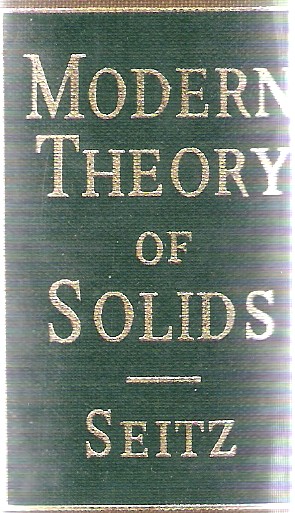

'A well-written text.. Should find a wide readership, especially among graduate students.' Pankove, RCA. The field of solid state theory, including crystallography, semi-conductor physics, and various applications in chemistry and electrical engineering, is highly relevant to many areas of modern science and industry. Professor Harrison's well-known text offers an excellent one-year graduate course in this active and important area of research. While presenting a broad overview of the fundamental concepts and methods of solid state physics, including the basic quantum theory of solids, it surpasses more theoretical treatments in its practical coverage of physical applications.
Harrison, Walter A. (Walter Ashley), 1930. Applied quantum mechanics / Walter A. Needed for that physics student to use the knowledge of quantum theory he. Used in solid-state lasers to enhance the laser performance.
This feature makes the book especially useful to specialists in other fields who many encounter solid state problems in their own work. At least one year of quantum mechanics is required; however, the author introduces more advanced methods as needed. Because virtually all of the properties of solids are determined by the valence electrons, the author devotes the first third of the book to electron states, including solid types and symmetry, band structure, electron dynamics, the self-consistent-field approximation, energy-band calculations, semi-conductor and semi-metal bands, impurity states, the electronic structure of liquids, and other topics.
Harrison then turns to a more systematic treatment of the electronic properties of solids, focusing on thermodynamic properties, transport properties (including the Boltzmann equation), semi-conductor systems, screening, optical properties, the Landau theory of Fermi liquids, and amorphous semi-conductors. In the final two chapters, Professor Harrison offers a cogent treatment of lattice vibrations and atomic properties and cooperative phenomena (magnetism and superconductivity). In addition to traditional background information, the book features penetrating discussions of such currently active problems as the Mott transition, the electronic structure of disordered systems, tunneling the Kondo effect, and fluctuation near critical points. In an important sense, the entire text constitutes a major vehicle for the clarification of quantum mechanics, resulting from, among other factors, a comparison of the semi-classical (Boltzmann equation) treatment of screening and the corresponding quantum (Liouville equation) treatment.
Learning Solid State Physics involves a certain degree of maturity, since it involves tying together diverse concepts from many areas of physics. The objective is to understand, in a basic way, how solid materials behave. To do this one needs both a good physical and mathematical background. One definition of Solid State Physics is it is the study of the physical (e.g.
The electrical, dielectric, magnetic, elastic, and thermal) properties of solids in terms of basic physical laws. In one sense, Solid State Physics is more like chemistry than some other branches of physics because it focuses on common properties of large classes of materials. It is typical that Solid State Physics emphasizes how physics properties link to electronic structure. We have retained the term Solid State Physics, even though Condensed Matter Physics is more commonly used.
Condensed Matter Physics includes liquids and non-crystalline solids such as glass, which we shall not discuss in detail. Modern Solid State Physics came of age in the late thirties and forties, and had its most extensive expansion with the development of the transistor, integrated circuits, and microelectronics. Most of microelectronics however is limited to the properties of inhomogeneously doped semiconductors. Solid State Physics includes many other areas of course; among the largest of these are ferromagnetic materials, and superconductors. Just a little less than half of all working physicists are in Condensed Matter.
Instrukciya po ohrane truda parogenerator. A course in Solid State Physics typically begins with three broad areas: (1) How and why atoms bind together to form solids, (2) Lattice Vibrations and Phonons, and (3) Electrons in Solids. One would then typically apply the above to (4) Interactions especially of electrons with phonons, (5) Metals, the Fermi Surface and Alloys, (6) Semiconductors, (7) Magnetism, (8) Superconductivity, (9) Dielectrics and Ferroelectrics, (10) Optical Properties, (11) Defects, and (12) Certain other modern topics such as layered materials, quantum Hall effect, mesoscopics, nanophysics, and soft condensed matter. In this book, we will consider all of these.
- Author: admin
- Category: Category